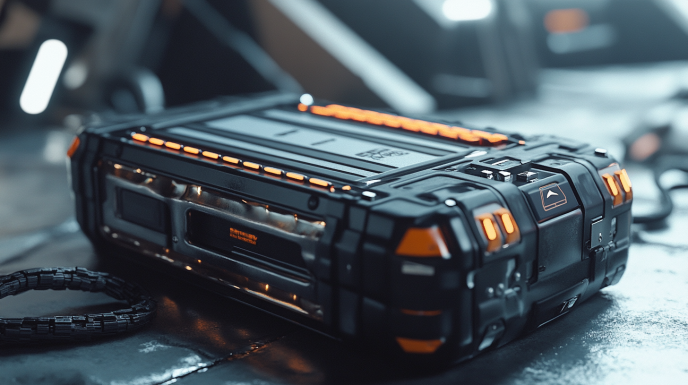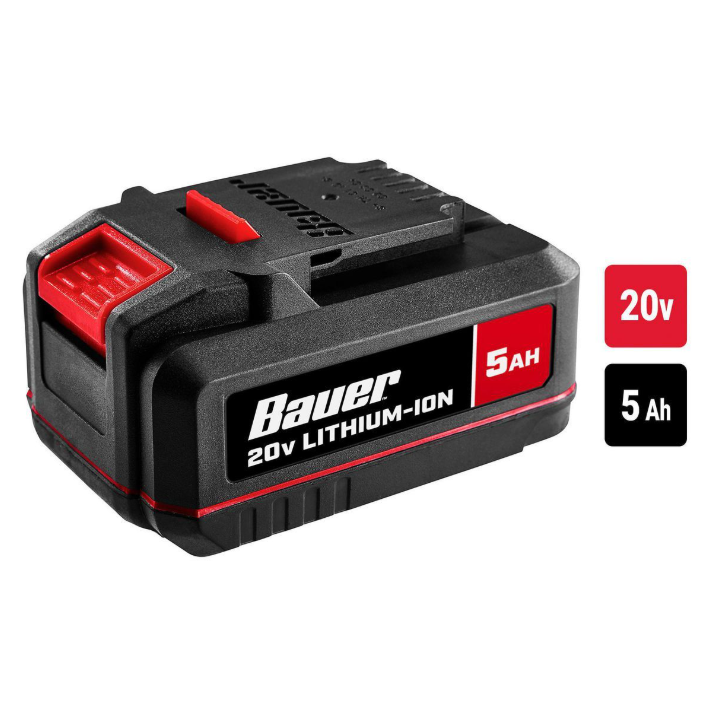
BAUER 20V 5 Ah High-Capacity Lithium-Ion Battery
- 5 Ah capacity for high-demand tools
- Easy-view fuel gauge displays remaining charge
- Works with all BAUER™ 20V cordless tools
- Delivers maximum performance on a partial charge
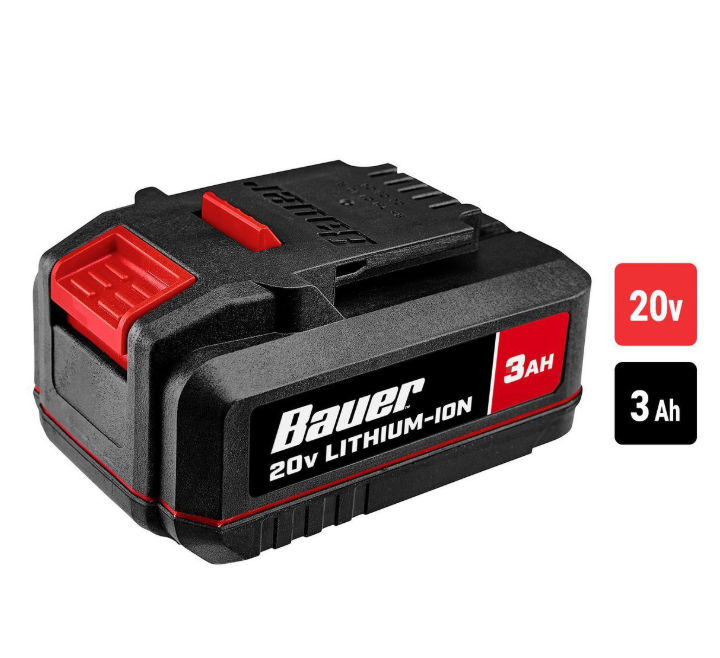
BAUER 20V 3 Ah High-Capacity Lithium-Ion Battery
- 2X more power than 1.5 Ah batteries
- Easy-view fuel gauge
- Works with all BAUER™ cordless tools
- Can be used with partial charge
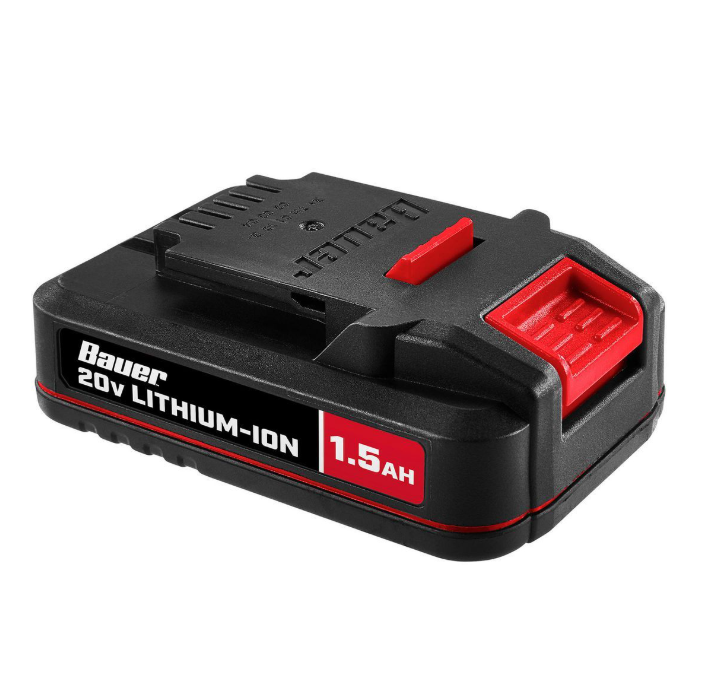
BAUER 20V 1.5 Ah Lithium-Ion Compact Battery
- Compact and lightweight
- Easy-view fuel gauge
- Works with all BAUER™ cordless tools
- Can be used with partial charge
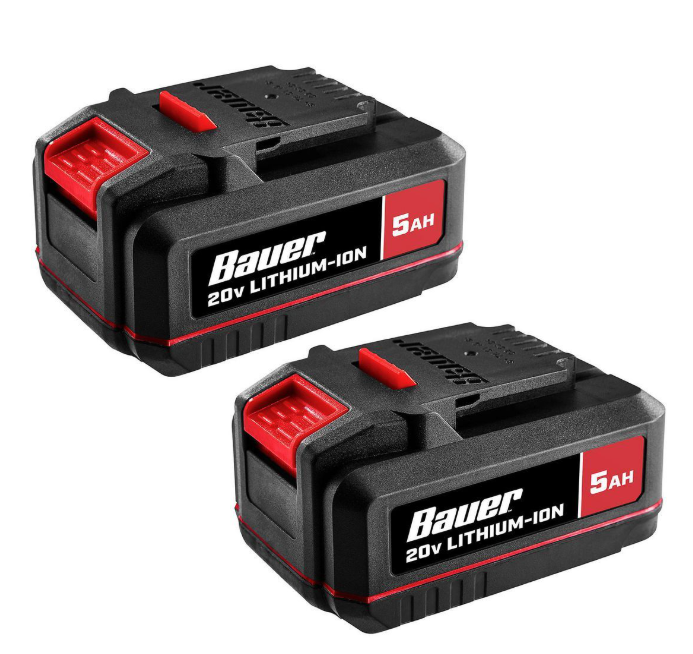
BAUER 20V 5 Ah High-Capacity Lithium-Ion Battery Bundle, 2-Pack
- Two 5 Ah capacity batteries for high-demand tools
- Easy-view fuel gauge displays remaining charge
- Works with all BAUER™ 20V cordless tools
- Delivers maximum performance on a partial charge
Powering Your Projects with Precision and Performance
In the world of power tools, the battery is the unsung hero that keeps your projects moving forward. For DIY enthusiasts and professionals alike, Bauer batteries have become a cornerstone of reliable, affordable power tool technology. But with so many options, specifications, and considerations, navigating the world of Bauer batteries can feel overwhelming. Whether you’re a weekend warrior or a seasoned contractor, understanding these power sources can save you time, money, and frustration.
Let’s dive deep into everything you need to know about Bauer batteries in 2025, from basic specifications to troubleshooting, compatibility, and beyond.
What Exactly Is a Bauer Battery?
Bauer batteries are lithium-ion power sources designed specifically for Bauer power tools, which are exclusively sold through Harbor Freight. These batteries represent the heart of the Bauer power tool ecosystem, which has carved out a significant niche in the market as a value-oriented alternative to premium brands.
The Bauer line features 20V lithium-ion batteries that power everything from drills and impact drivers to reciprocating saws and angle grinders. These batteries utilize modern lithium-ion technology, offering significant advantages over older nickel-cadmium (NiCad) batteries, including:
- Lighter weight for the same power output
- No memory effect (meaning you can charge them at any time without degrading capacity)
- Longer overall lifespan
- Slower self-discharge when not in use
- More consistent power output throughout the discharge cycle
The distinctive blue housing of Bauer batteries has become a familiar sight on job sites and in home workshops across the country. While they may not carry the name recognition of brands like DeWalt or Milwaukee, Bauer batteries have earned a reputation for delivering reliable performance at a more accessible price point.
Battery Life: How Long Can You Expect a Bauer Battery to Last?
When discussing battery life, we need to consider two different metrics: runtime per charge and overall lifespan.
Runtime Per Charge
The runtime of a Bauer battery depends primarily on three factors:
- Battery capacity (measured in amp-hours or Ah)
- The specific tool being used
- The intensity of the work being performed
Bauer offers batteries in several capacities, with the most common being:
- 1.5Ah (compact/lightweight)
- 3.0Ah (standard)
- 5.0Ah (extended runtime)
As a general guideline, a 3.0Ah Bauer battery will provide approximately:
- 1-2 hours of continuous use for light-duty tools like drills on simple tasks
- 30-45 minutes for medium-duty applications like sawing softwood
- 15-30 minutes for heavy-duty applications like cutting hardwood or masonry
The 5.0Ah battery extends these runtimes by roughly 60-70% compared to the 3.0Ah version, making it ideal for longer projects or professional use.
Overall Lifespan
With proper care, a Bauer battery typically lasts between 2-3 years of regular use before significant capacity degradation occurs. Most users report being able to complete 300-500 charge cycles before noticing a substantial decrease in runtime.
Factors that can extend your Bauer battery’s lifespan include:
- Storing batteries at around 40-60% charge (not fully charged or depleted)
- Keeping batteries at moderate temperatures (avoid extreme heat or cold)
- Using only Bauer-approved chargers
- Avoiding complete discharge whenever possible
- Cleaning the battery terminals regularly
Many professionals keep their Bauer batteries in rotation, using them regularly but not excessively, which seems to promote longer overall battery health.
Where Can You Purchase Bauer Batteries?
Bauer is a Harbor Freight exclusive brand, which means authentic Bauer batteries are only available through:
- Harbor Freight retail stores (over 1,100 locations across the United States)
- The official Harbor Freight website (harborfreight.com)
- Harbor Freight’s official presence on marketplace platforms
While you might occasionally find Bauer batteries on third-party marketplaces or resale platforms, purchasing directly from Harbor Freight ensures you’re getting an authentic product covered by the manufacturer’s warranty.
Harbor Freight frequently runs promotions on Bauer batteries and sometimes offers them as free add-ons with tool purchases. Their “Inside Track Club” membership program also provides additional discounts for regular customers.
As of 2025, typical pricing for Bauer batteries ranges from:
- $29.99-$39.99 for 1.5Ah batteries
- $49.99-$59.99 for 3.0Ah batteries
- $69.99-$79.99 for 5.0Ah batteries
However, sales and promotions can reduce these prices significantly, making it worthwhile to watch for special offers if you’re not in immediate need of a replacement.
Compatibility: Do Bauer Batteries Work With Other Tools?
This is one of the most common questions among power tool users, especially those with multiple brands in their collection. The short answer is: Bauer batteries are designed specifically for Bauer tools and are not officially compatible with other brands.
Bauer uses a proprietary connection system that physically prevents their batteries from fitting directly into tools from other manufacturers. This “walled garden” approach is common among power tool brands, encouraging users to stay within one ecosystem.
That said, there are some important compatibility notes:
- All 20V Bauer batteries work with all 20V Bauer tools – There’s complete cross-compatibility within the Bauer 20V lineup.
- Bauer batteries are NOT compatible with Hercules, Warrior, or other Harbor Freight power tool lines – Despite being sold at the same retailer, these are separate systems with different connection mechanisms.
- Battery adapters exist, but with caveats – Third-party adapters can be found online that claim to allow Bauer batteries to power tools from other brands (or vice versa). However, these adapters come with significant risks:
- No safety certification or testing
- Potential for damage to tools or batteries
- Voiding of warranties
- Inconsistent performance
For safety and reliability reasons, it’s generally best to use Bauer batteries exclusively with Bauer tools as intended by the manufacturer.
Charging Up: How to Properly Charge Your Bauer Battery
Charging a Bauer battery is straightforward, but following best practices can significantly extend battery life and performance:
- Use only Bauer-approved chargers – The standard Bauer 20V charger and the Bauer Rapid Charge system are designed specifically for these batteries.
- The charging process is simple:
- Insert the battery into the charger
- Connect the charger to a standard 120V outlet
- The indicator light will show red while charging
- When fully charged, the light turns green
- Remove the battery once charged (don’t leave it on the charger indefinitely)
- Charging times vary by battery capacity and charger type:
- Standard charger: 30-45 minutes for 1.5Ah, 60-90 minutes for 3.0Ah, 2-3 hours for 5.0Ah
- Rapid charger: 15-20 minutes for 1.5Ah, 30-45 minutes for 3.0Ah, 60-90 minutes for 5.0Ah
- Temperature considerations are important:
- Optimal charging temperature is between 50°F and 86°F (10°C to 30°C)
- Most Bauer chargers have thermal protection and will pause charging if the battery is too hot or cold
- Allow cold batteries to warm up to room temperature before charging
- Let hot batteries (after heavy use) cool down before charging
- Break-in period for new batteries:
- For optimal performance, the first 3-5 charge cycles should be full charges and nearly full discharges
- After the break-in period, partial charging is fine and even preferable
Remember that lithium-ion batteries like those used in Bauer tools don’t have a memory effect, so you don’t need to fully discharge them before recharging. In fact, shallow discharges (using 20-80% of capacity) tend to extend overall battery life.
Finding the Best Charger for Your Bauer Batteries
Bauer offers two primary charging options for their 20V battery lineup:
Standard Bauer 20V Lithium-Ion Battery Charger
This basic charger comes included with most Bauer tool kits and is available separately for around $20-25. Features include:
- Charging indicator light
- Basic thermal protection
- Compact design
- Wall-mountable
While functional, this charger is relatively slow, making it best suited for overnight charging or users with only one or two batteries.
Bauer Rapid Charger
The premium option in the lineup costs approximately $40-50 and offers significant advantages:
- 2-3x faster charging times
- Enhanced cooling system
- Better thermal protection
- Battery health monitoring
- More robust construction
- Dual indicator lights (charging status and battery health)
For most users, the Bauer Rapid Charger is worth the additional investment, especially if you:
- Use your tools professionally
- Own multiple batteries
- Work on time-sensitive projects
- Need quick turnaround between battery swaps
Many professionals and serious DIYers opt to have both charger types: the rapid charger for during-project use and the standard charger for overnight maintenance charging.
A third option has emerged in the form of multi-port chargers that can charge several batteries simultaneously. While Bauer doesn’t currently offer an official multi-battery charging station, third-party options exist, though they come with the same compatibility and warranty concerns as other non-Bauer accessories.
Understanding Amp-Hours: What Capacity Do Bauer Batteries Offer?
Amp-hours (Ah) measure a battery’s capacity—essentially how much energy it can store. Think of it like the size of your gas tank in a car.
Bauer currently offers three primary battery capacities in their 20V lineup:
1.5Ah Compact Battery
- Best for: Light-duty tasks, compact tools, situations where weight matters more than runtime
- Advantages: Lighter weight, lower cost, faster charging
- Disadvantages: Shortest runtime, may struggle with high-demand tools
- Ideal tools: Drills, impact drivers, small sanders, flashlights
- Weight: Approximately 0.7 lbs
3.0Ah Standard Battery
- Best for: General-purpose use, balanced performance for most DIY applications
- Advantages: Good balance of runtime and weight, reasonable cost
- Disadvantages: Middle-of-the-road in all categories
- Ideal tools: Circular saws, reciprocating saws, medium-duty applications
- Weight: Approximately 1.1 lbs
5.0Ah Extended Runtime Battery
- Best for: Professional use, demanding applications, all-day projects
- Advantages: Longest runtime, fewer battery swaps, better performance in high-draw tools
- Disadvantages: Heavier, more expensive, longer charging time
- Ideal tools: Angle grinders, high-demand saws, continuous professional use
- Weight: Approximately 1.5 lbs
To put these capacity differences in perspective, a 5.0Ah battery holds approximately 3.3 times the energy of a 1.5Ah battery and 1.7 times that of a 3.0Ah battery.
Interestingly, the higher-capacity batteries often deliver slightly better performance in high-demand applications beyond just runtime. This is because the larger batteries can distribute the current demand across more cells, reducing strain on any individual cell and allowing for more consistent power delivery.
Troubleshooting: Why Isn’t My Bauer Battery Charging?
Few things are more frustrating than a battery that won’t charge when you need it. Here are the most common reasons Bauer batteries fail to charge, along with potential solutions:
1. Battery is Too Hot or Cold
Symptoms: Charger light blinks but doesn’t begin charging
Solution: Allow the battery to reach room temperature (50-86°F) before attempting to charge
2. Dirty or Corroded Terminals
Symptoms: Intermittent charging, charger doesn’t recognize battery
Solution: Clean battery and charger terminals with alcohol and a cotton swab, being careful not to bend contact pins
3. Battery in Protection Mode
Symptoms: Battery appears completely dead, won’t charge
Solution: Try a reset procedure:
- Remove from charger
- Wait 30 minutes
- Insert battery with very slight pressure
- Sometimes a brief (5-10 second) insertion into a tool can wake up the battery
4. Faulty Charger
Symptoms: Multiple batteries fail to charge on same charger
Solution: Test batteries in a different Bauer charger; replace charger if determined to be faulty
5. Battery Has Reached End of Life
Symptoms: Battery charges but depletes very quickly, gets unusually hot during charging
Solution: Replace the battery; consider recycling the old one
6. Internal Battery Damage
Symptoms: Physical damage visible, battery swollen, unusual odors
Solution: Discontinue use immediately and recycle the battery; attempting to charge damaged batteries can be dangerous
If your battery won’t charge and is still under warranty (typically 90 days to 2 years depending on when purchased), contact Harbor Freight customer service or visit a store for potential warranty service.
Warranty Coverage: What Protection Do Bauer Batteries Include?
As of 2025, Bauer batteries come with different warranty periods depending on the purchase date and specific promotion:
- Standard warranty: 90 days from date of purchase
- Extended warranty: Available at additional cost, extends coverage to 2 years
- Promotional warranties: Occasionally Harbor Freight offers special 1-year or 2-year warranty promotions on Bauer batteries
The warranty generally covers manufacturing defects and premature failure but excludes:
- Normal wear and tear
- Damage from misuse or accidents
- Problems resulting from improper charging
- Issues caused by extreme temperatures
- Damage from using non-Bauer chargers
To make a warranty claim:
- Retain your original receipt
- Bring the battery to any Harbor Freight store, or
- Contact customer service at 1-800-444-3353
Harbor Freight typically requires the original battery for exchange and may perform basic testing to verify the issue isn’t due to excluded causes. The warranty process is generally straightforward, especially when handled in-store.
Some professional users find value in the extended warranty given the work demands they place on their batteries, while occasional DIYers might find the standard warranty sufficient given the relatively low replacement cost.
Quality Assessment: Are Bauer Batteries Good for Power Tools?
The quality question is perhaps the most subjective aspect of the Bauer battery discussion. Based on user reports, professional reviews, and general market positioning, here’s a balanced assessment:
Strengths of Bauer Batteries:
- Excellent value proposition: Typically 30-50% less expensive than premium brands
- Reliable performance: Consistent power delivery throughout most of the discharge cycle
- Good compatibility: Complete interoperability within the Bauer ecosystem
- Decent longevity: Most users report 2-3 years of regular use
- Convenient availability: Easy to purchase at Harbor Freight locations nationwide
- Improving technology: Each new generation has shown refinements
Limitations of Bauer Batteries:
- Not the absolute highest performance: Premium brands may offer slightly better power delivery for demanding professional applications
- Shorter warranty period than some competing brands
- Limited ecosystem compared to larger tool brands
- Occasionally inconsistent manufacturing quality
- Less robust battery management system than premium options
The consensus among most users is that Bauer batteries represent an excellent balance of performance and value for most DIY users and even many professionals. They’re particularly well-regarded in the “prosumer” category—serious hobbyists and occasional professionals who need reliability without premium pricing.
For context, in benchmark testing, Bauer batteries typically deliver 85-90% of the performance of premium brands at roughly half the price point, making them a compelling option for budget-conscious users.
DIY Potential: Can You Rebuild a Bauer Battery?
While not officially supported by Harbor Freight, some technically inclined users have successfully rebuilt Bauer batteries. However, this process comes with significant caveats:
What Battery Rebuilding Involves:
- Disassembling the battery housing (usually requires breaking tamper-evident seals)
- Removing the old cells
- Replacing with new 18650 lithium-ion cells of equivalent specifications
- Reconnecting the battery management system
- Reassembling the housing (often requiring adhesives or custom solutions)
Important Considerations Before Attempting:
- Safety risks are substantial: Lithium-ion batteries can cause fires if improperly handled
- Technical knowledge required: Understanding of electrical systems and battery chemistry is essential
- Warranty voiding: Any modification immediately voids any remaining warranty
- Cost-benefit questionable: By the time you purchase quality cells and materials, savings may be minimal
- Performance may suffer: The battery management system is calibrated for specific cells
For most users, rebuilding is not recommended due to the safety risks and technical challenges involved. The modest cost savings (typically $10-20 versus a new battery) rarely justify these risks.
If your battery has failed and is out of warranty, recycling it properly and purchasing a replacement is generally the safest and most practical approach.
Environmental Responsibility: Recycling Your Old Bauer Battery
Lithium-ion batteries, including Bauer batteries, should never be disposed of in regular trash due to:
- Fire hazards in waste processing facilities
- Toxic materials that can leach into soil and water
- Valuable materials that can be recovered and reused
Fortunately, recycling Bauer batteries is relatively simple:
Recycling Options:
- Return to Harbor Freight: Most Harbor Freight stores accept used Bauer batteries for recycling at no charge, even if you’re not purchasing a replacement
- Local battery recycling centers: Many communities have dedicated battery recycling facilities that accept lithium-ion power tool batteries
- Electronics retailers: Stores like Best Buy, Staples, and Lowe’s often have battery recycling programs that accept all brands of rechargeable batteries
- Community hazardous waste collection: Many municipalities hold regular collection events for items like batteries
- Mail-in programs: Services like Call2Recycle provide prepaid shipping labels for battery recycling (though fees may apply)
Before recycling, it’s advisable to:
- Discharge the battery to around 20-30% capacity (not completely)
- Cover the terminals with non-conductive tape to prevent shorts
- Package in a plastic bag to contain any potential leaks
Recycling lithium-ion batteries recovers valuable materials including cobalt, nickel, copper, and aluminum, reducing the environmental impact of producing new batteries and preventing hazardous materials from entering landfills.
Capacity Comparison: 3.0Ah vs. 5.0Ah Bauer Batteries
The choice between 3.0Ah and 5.0Ah batteries is one of the most common decisions Bauer users face. Here’s a detailed breakdown of the differences:
3.0Ah Battery
- Runtime: Approximately 60% of the 5.0Ah battery
- Weight: About 30% lighter than the 5.0Ah version
- Cost: Typically $15-20 less expensive
- Charging time: 30-45 minutes faster on standard chargers
- Best applications: Lighter-duty tasks, overhead work, precision tools where weight affects handling
5.0Ah Battery
- Runtime: Up to 67% longer than the 3.0Ah battery
- Performance: Generally maintains higher power output under heavy loads
- Heat management: Often stays cooler during intensive applications
- Tool life: May extend motor life in high-demand tools by reducing strain
- Best applications: Professional use, all-day projects, power-hungry tools like saws and grinders
The performance difference becomes most noticeable in high-demand applications. For example, when cutting hardwood with a circular saw, a 3.0Ah battery might complete 25-30 linear feet of cutting before depletion, while a 5.0Ah battery could manage 40-50 feet.
Many users find that having a mix of both capacities offers the best flexibility:
- 3.0Ah batteries for drills, impact drivers, and lighter tools
- 5.0Ah batteries for saws, grinders, and other high-draw applications
This mixed approach optimizes both cost and performance across different applications.
Cost Analysis: How Much Should You Expect to Pay for Bauer Batteries?
Bauer batteries are positioned as a value alternative to premium brands, and their pricing reflects this positioning. As of 2025, typical pricing (outside of sales or promotions) is:
Standard Pricing:
- 1.5Ah Battery: $29.99-$39.99
- 3.0Ah Battery: $49.99-$59.99
- 5.0Ah Battery: $69.99-$79.99
- Standard Charger: $19.99-$24.99
- Rapid Charger: $39.99-$49.99
- Battery + Charger Kits: $59.99-$89.99 (depending on battery size)
Value Proposition:
To put these prices in context, comparable batteries from premium brands typically cost:
- 50-70% more for similar capacities (3.0Ah from premium brands ranges from $79-$99)
- Harbor Freight frequently runs promotions that can reduce prices by 20-30%
- “Inside Track Club” members often receive additional discounts
Cost Per Ah Comparison:
- Bauer: Approximately $16-20 per Ah
- Mid-tier brands: Approximately $20-25 per Ah
- Premium brands: Approximately $25-35 per Ah
This value proposition is a key part of why Bauer has gained popularity, especially among DIY users and cost-conscious professionals. The performance-to-price ratio is generally considered excellent, even if the absolute performance falls slightly short of premium alternatives.
Troubleshooting Techniques: How to Reset a Bauer Battery
Sometimes a Bauer battery may enter a protection mode that prevents charging or discharging. This is a safety feature designed to prevent damage, but it can be frustrating when it happens unexpectedly.
The good news is that in many cases, you can reset the battery’s internal protection circuit:
Standard Reset Procedure:
- Remove the battery from any tool or charger
- Allow it to rest for 30-60 minutes at room temperature
- Insert it into the charger with gentle pressure
- If the charger doesn’t recognize it, remove and reinsert 2-3 times
- If still unresponsive, insert the battery into a tool and pull the trigger briefly (5 seconds maximum)
- Return to the charger and attempt charging again
Deep Reset Method (for persistently unresponsive batteries):
- Allow the battery to sit unused for 24 hours
- Place in freezer for 10-15 minutes (no longer)
- Let it return to room temperature (approximately 30 minutes)
- Try the standard charging procedure
It’s important to note that these reset procedures only work for batteries with protection circuit issues—they won’t revive batteries with physical damage or cells that have degraded beyond usability.
If a battery consistently requires resetting, it may be approaching the end of its useful life, and replacement should be considered.
Technical Specifications: What Voltage Do Bauer Batteries Use?
Bauer power tools use a 20V maximum lithium-ion battery system. This specification requires some explanation:
The “20V Max” rating refers to the maximum voltage when the battery is fully charged and not under load. During actual use, the nominal operating voltage is 18V, which is standard across the industry.
This 20V/18V distinction is common in power tool marketing:
- “20V Max” tools (like Bauer, DeWalt, and others) have a nominal working voltage of 18V
- Brands that advertise “18V” tools (like Milwaukee and Makita) are referring to the same nominal voltage
- The actual performance is virtually identical between “20V” and “18V” tools of similar quality
The 20V Bauer battery pack contains five lithium-ion cells in series, each with:
- Nominal voltage: 3.6V per cell
- Operating voltage range: 3.0V (depleted) to 4.2V (fully charged)
- 5 cells × 3.6V = 18V nominal
- 5 cells × 4.2V = 21V maximum (rounded down to 20V for marketing)
This standardized voltage allows Bauer to design their entire tool lineup around a consistent power platform while optimizing performance for each specific application.
Diagnostic Process: Testing a Bauer Battery for Faults
When your Bauer battery isn’t performing as expected, a systematic diagnostic approach can help determine whether the battery is at fault and whether it can be salvaged:
Basic Visual Inspection:
- Check for physical damage to the casing
- Look for any signs of leakage or corrosion
- Examine the terminals for dirt, corrosion, or damage
- Check for unusual swelling or deformation
Functional Testing:
- Charge test: Does the battery accept a charge? How long does it hold the charge?
- Voltage test: Using a multimeter, check voltage across terminals (should be 18-20V when charged)
- Performance test: Try the battery in different tools to isolate whether the issue is tool-specific
- Load test: Use the battery in a high-demand application and note how quickly power diminishes
Common Fault Patterns:
- Battery charges but depletes quickly: Likely cell degradation/age
- Battery doesn’t charge at all: Possible protection circuit trigger or dead cells
- Battery works in some tools but not others: Possible connection issue or tool-specific power requirements
- Battery gets unusually hot during charging or use: Potential internal short or damaged cell
For most users without specialized equipment, these basic tests can determine whether a battery needs replacement or if the issue might be with the charger or tool instead.
If you determine a battery is beyond recovery and out of warranty, proper recycling is the appropriate next step.
Brand Compatibility: Are Bauer Batteries Interchangeable With Other Brands?
The short and official answer is no—Bauer batteries are designed exclusively for Bauer tools and are not interchangeable with other brands.
Each power tool brand uses proprietary connection systems, battery management systems, and communication protocols between the battery and tool. These differences exist for several reasons:
- Physical connections: The physical shape and arrangement of terminals differ between brands
- Electrical compatibility: Voltage may be similar, but current handling and other electrical characteristics vary
- Communication protocols: Modern batteries communicate with tools and chargers using brand-specific protocols
- Business model: Companies want to keep users within their ecosystem
While third-party adapters claim to bridge these compatibility gaps, they come with significant drawbacks:
- No safety certification from either manufacturer
- Potential for damage to both the battery and tool
- Voiding of warranties
- Bypassing of important safety features
- Inconsistent performance
For safety, reliability, and warranty reasons, it’s best to use Bauer batteries exclusively with Bauer tools as designed.
If you’re invested in multiple battery platforms, the most practical approach is to maintain separate batteries for each system rather than attempting cross-compatibility.
Environmental Considerations: Using Bauer Batteries in Cold Weather
Temperature has a significant impact on lithium-ion battery performance, and cold weather presents particular challenges for Bauer and all lithium-ion batteries:
Effects of Cold on Bauer Batteries:
- Reduced capacity: Batteries may deliver only 50-70% of normal capacity below 32°F (0°C)
- Slower chemical reactions: Reduced power output, especially for high-demand applications
- Increased internal resistance: Tools may seem less powerful
- Charging limitations: Most lithium-ion batteries cannot be safely charged below 32°F (0°C)
Best Practices for Cold Weather Use:
- Keep batteries warm: Store batteries indoors or in insulated containers when not in use
- Rotate batteries: Have multiple batteries and keep spares in a warm pocket while using one
- Warm up before charging: Never charge cold batteries; allow them to reach room temperature first
- Expect reduced performance: Plan for shorter runtime and slightly less power
- Use the right capacity: 5.0Ah batteries generally perform better in cold than smaller capacities
- Avoid complete discharge: Cold temperatures combined with complete discharge can permanently damage cells
With proper care, Bauer batteries can function effectively down to about 20°F (-6°C), though with reduced capacity. Below that temperature, performance becomes increasingly compromised, and risk of damage increases.
For users in consistently cold climates, there are specialized battery heaters and insulated sleeves available, though these are typically designed for premium battery platforms and may require modification for use with Bauer batteries.
Common Issues: What Problems Do Bauer Battery Users Typically Encounter?
While Bauer batteries offer good value and reliability, users do report several recurring issues. Being aware of these common problems can help you avoid them or address them quickly:
1. Connection Issues
Symptoms: Intermittent power, tool cutting out during use
Causes: Dirt or debris in connection points, bent terminals, wear on contact points
Solutions: Clean connections regularly with compressed air and alcohol; check for bent pins
2. Premature Capacity Loss
Symptoms: Battery depletes much faster than when new
Causes: Frequent deep discharges, exposure to high temperatures, charging while hot
Solutions: Avoid complete discharge, let batteries cool before charging, store properly
3. Charging Problems
Symptoms: Battery won’t charge or charges very slowly
Causes: Charger issues, protection circuit activation, extreme temperatures
Solutions: Try reset procedures, ensure proper temperature range, check/replace charger
4. Battery Management System Failures
Symptoms: Battery shows incorrect charge level, shuts down unexpectedly
Causes: Electronic component failures, firmware issues
Solutions: Try reset procedures; if persistent, may require warranty service
5. Physical Damage
Symptoms: Cracked housing, loose components, exposed cells
Causes: Drops, impacts, crushing, improper storage
Solutions: Handle with care; use tool bags with padded sections; replace damaged batteries immediately
6. Thermal Management Issues
Symptoms: Battery gets extremely hot during use or charging
Causes: High-demand applications, cell degradation, internal shorts
Solutions: Allow cooling breaks during heavy use; if persistently overheating, discontinue use
Most of these issues can be prevented through proper care and maintenance. The single most important factor in Bauer battery longevity is temperature management—keeping batteries from getting too hot or too cold during use, charging, and storage.
Conclusion: Making the Most of Your Bauer Battery Investment
Bauer batteries represent a solid value proposition in the power tool market, offering a good balance of performance, reliability, and affordability. While they may not match the absolute top-tier performance of premium brands costing twice as much, they deliver more than enough power and runtime for the vast majority of DIY and many professional applications.
To maximize your investment in Bauer batteries:
- Choose the right capacity for your needs: 3.0Ah for general use, 5.0Ah for demanding applications
- Consider the Rapid Charger if you regularly use your tools or need minimal downtime
- Practice proper battery care: Moderate temperatures, avoid deep discharge, clean connections
- Keep an eye on promotions: Harbor Freight frequently offers significant discounts
- Maintain a rotation system if you have multiple batteries to distribute wear evenly
Whether you’re building a deck, renovating a kitchen, or tackling professional projects, Bauer batteries can provide the power you need without breaking the bank. By understanding their capabilities, limitations, and proper care, you can ensure they remain reliable partners in your projects for years to come.
Bauer batteries have become a cornerstone of reliable, affordable power tool technology for good reason—they deliver where it matters most: consistent performance at a reasonable price.

